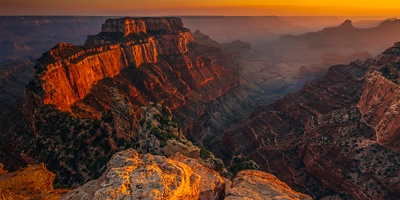
If you want to really experience the Grand Canyon, you need to slow down and walk. Wherever you are, whether in a vast place like the Grand Canyon or your local park, hiking is the best way to immerse yourself in the landscape. While you walk, you can observe how the environment changes, take in the little stuff you’d miss if going faster, and easily stop to explore anything that catches your eye. And at the Grand Canyon, there’s a lot to catch the eye.
In this guide we’ll highlight everything you need to know about day hiking in the Grand Canyon, from the right gear to the best trails to take. We’ll cover:
- North versus South Rim
- When to Go
- Gear and Safety
- South Rim Day Hikes
- North Rim Day Hikes
North or South Rim?
When visiting the Grand Canyon, you’ll likely need to choose which rim you’ll head to (they are separated by a 4.5-hour drive).
The South Rim is the most popular starting point for visiting the Grand Canyon. It’s accessible year-round and is far more developed than the North Rim, with visitor centers, museums, stores, hotels, restaurants, and campgrounds. The South Rim is 3.5 hours from Phoenix.
The North Rim offers a much quieter and more remote experience. It has only one campground and one lodge, and can’t be accessed by car in the winter. The North Rim is 4.5 hours from Las Vegas.
When to Go
You can hike in the Grand Canyon all year, but the seasons offer a wide variety of conditions. Here’s what to expect:
Spring: This is a gorgeous season for visiting the Grand Canyon. Temperatures are moderate, creeks and springs are more likely to be flowing, and flowers bloom below the rim.
Summer: This is peak season for the park, or at least certain areas of it. But even in summer, it’s possible to find solitude. Hit the trail before sunrise or seek out less popular areas (for example, go to the North Rim instead of the South Rim). Downside: Summer can be extremely hot below the rim (as much as 30 degrees warmer than on top), and afternoon thunderstorms are common.
Fall: Like spring, this is an excellent time to visit because of the moderate weather. Rain is less likely in the fall and the colors of cottonwoods changing, below the rim, are spectacular.
Winter: This is the only season when the Grand Canyon is (relatively) deserted. The South Rim hot spots are still busy, but apart from those areas, solitude is easy to find. The catch? At an elevation of 7,000 feet, the South Rim is snowy and cold in the winter. Icy trails can be difficult to navigate at the top, but if you descend into the canyon you’ll find much more moderate conditions after just a couple miles of hiking.
Gear and Safety
It’s always important to stay hydrated while hiking, but in the Grand Canyon, consider it mandatory. Extreme heat and steep trails are a dangerous combination if you’re not prepared. Fortunately, you can do three things to ensure your safety. 1) Carry a gallon of water per person per day in warm weather (if you plan on getting water below the rim, check with rangers on current sources); 2) Start early and avoid hiking during the hottest part of the day; 3) Be conservative about mileage and elevation change.
Packing list: Always pack the 10 Essentials, and in the Grand Canyon put special emphasis on water (see above), food (more than you think you’ll need), navigation, a headlamp, and sun protection (sunscreen, sunhat, sunglasses, and sun protective clothing).
Trekking poles: Anyone hiking below the rim will be glad to have trekking poles. They help reduce impact on your joints, which can be considerable when descending thousands of feet.
Traction: In the winter, in addition to appropriate cold-weather clothing, traction devices are critical if the trail is icy. If you’re not comfortable with the conditions, take a hike along the flatter rim trails and enjoy spectacular views of the snow-covered canyon.
Mules: Mules are used in the Grand Canyon to transport goods, people, and baggage. You’ll likely see the mule trains from a distance or encounter them while hiking on the Bright Angel or South Kaibab Trails. Avoid a negative encounter: Step off the trail as the mules approach (uphill side of the trail, away from the edge), stay quiet and still so you don’t spook them, and give the train about 50 feet before you start moving again.
Hiking below the rim: Remember, you’re descending into a steep canyon, and on a hike below the rim, the return trip is a lot harder than the first leg. Expect the climb back up to take twice as long as the trek down. The National Park Service advises hikers not to attempt reaching the river and back in one day, and especially not between the months of May and September. More than 250 people are rescued from the Grand Canyon each year, many due to heat exhaustion and dehydration. Experienced and fit hikers do make it to the river and back on a day hike, but don’t underestimate the challenge.





















